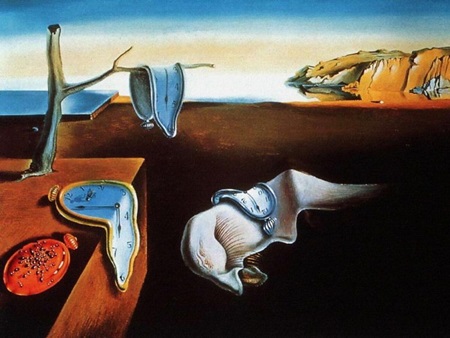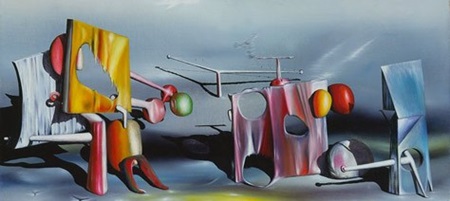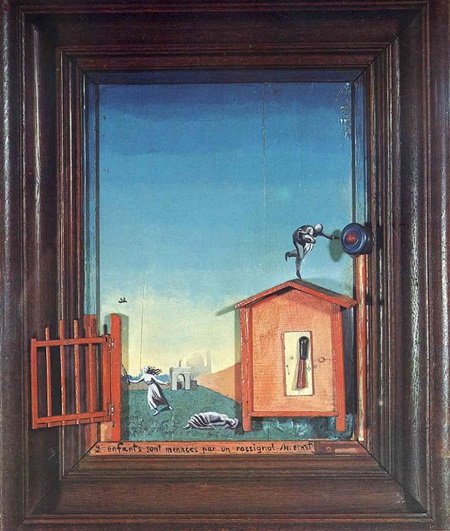 |

|

|
 |
 |

|
Surrealist Art (1924-1966)
"Surrealism is destructive, but it only destroys what it considers to be shackles limiting our vision" (Salvador Dalí). Surrealist art is distinguished by its dreamlike and anti-reality essence. Surrealist artists channel their imagination to create art that is abstract
and shieled from rationalism. Imagery, especially natural imagery, is a main theme in Surrealist art. Surrealists, particularly André Breton, believed that
rationalism was the cause of the World War I, therefore people needed to liberate "the unconcious mind." Surrealism was not only influenced by
prominent artists but also by Karl Marx and Signmund Freud. The most notable Surrealists were André Breton, Salvador Dalí, Yves Tanguy, André Masson, Max
Ernst, and many more.
|
Salvador Dalí (1904-1989)
Salvador Dalí was a well-known Spanish painter and printmaker. Influenced by Signmund Freud's writings about the subconcious mind and French Surrealists,
Dalí sought to create art that expressed his unconscious mind. Dalí relied on a method he called "the paranoid critical transformation method" which was a way to intrepret
the world around him by triggering a state of paranoia. Dalí was able to quickly produce art pieces and is recognized as being one of the best Surrealists.
The Persistence of Memory (1931)
The Persistence of Memory, an oil painting by Dalí, is one of the most famous Surrealist paintings.
The landscape in this painting is based on Dalí's hometown in Spain. The theme in this painting is time and perhaps how insignificant it is. The
painting is seemingly set in a desert where clocks have melted away. There is no movement in this painting not even in the water because there are no waves.
Dalí's painting exhibits the Surrealist art that is dream-like often challenging to interpret.
The Persistence of Memory can be found in the Museum of Modern Art.
|

|
Yves Tanguy (1900-1955)
Yves Tanguy was a French-born, American, Surrealist painter. Tanguy was perhaps the most loyal to Surrealist principles throught his career. Tanguy was
a self-taught painter who was skillfully able to balance both
rationalism and reality. Tanguy was a friend of André Breton and was known for his seemingly eccentric personality. Tanguy regularly contrasted colors and
used elements of line and shape.
Reply to Red (1943)
Reply to Red demonstrates Tanguy's abstract style that does not show a definite object like other Surrealists showed. Tanguy uses mosty primary colors and shows some contrast. This
painting demonstrates line, space and shape. Movement and unity are also shown in the painting, all of the shapes are linked together and cause the
viewer's eyes to move.
|

|
Max Ernst (1891-1976)
Max Ernst was a German-born painter who was one of the founders of Surrealism in 1924. Ernst also participated in the Dada art period prior to the
start of Surrealism. Ernst was a World War I veteran and had serious tramma from the war. Like Dalí, Ernst followed Freud's writings and theories
about the subconcious mind and incorporated into his art. Ernst would use automatism to find new techniques of creating patterns and shapes, especially since
he was a self-taught artist. After several tramatizing experiences in his life, Ernst had a lot of anxiety and created a bird alter-ego named Loplop.
Two Children are Threatened by a Nightingale (1924)
Ernst's Two Children are Threatened by a Nightingale is based on a dream he had when he had measles and the death of his sister.
A girl is shown holding what appears to be knife, a figure is lying down, and a third person is on the roof reaching for a knob. This painting also includes embelishments that add
detail to the painting including the gate and knob.
This oil painting on wood can be found at the Museum of Modern Art.
At the botton of the painting Ernst wrote, "At nightfall, at the outskirts of the village, two children are threatened by a nightingale."
|

|

|









